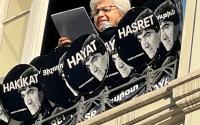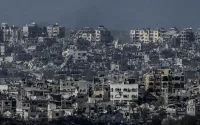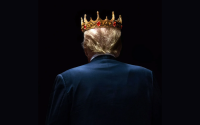In the present intifada, 323 Palestinian children under the age of 14 have been killed by IDF fire. Three recent examples from Nablus...Why waste ammunition? A few days ago, an Israel Defense Forces soldier fired at two boys in the casbah of Nablus. Just a lone bullet that penetrated the body of one of the boys, exited, penetrated the second boy, and killed both of them. Two 15-year-old boys standing with their arms around each other on the street that descends to the marketplace.The soldier didn't "confirm the kill" after his two victims fell; perhaps that is why nobody on our side was shocked by this horrific double killing. But in two homes in the casbah of Nablus, dead children were being mourned. One, Amar Banaat, was his mother's only child, born after 15 years of infertility; the other, Montasser Hadada, had lost his father only three months ago. On the wall, next to the picture of the two children, there is also one of their good friend Hani Kandil, who was killed in the same place in the casbah several months ago. Three pictures of dead children on the wall.Not far from there, in the casbah, they are mourning another child who was killed, who died with a huge hole in his chest. This is the home of Khaled Osta, who was 9 years old. Muataz Amudi, aged 3, was fortunate: The bullet just pierced his leg as his father carried him in his arms in the middle of the night, fleeing after the soldiers told them to evacuate their home.Nablus is mourning its children. Those among us - including the chief of staff - who were so horrified by the affair of the "confirmed killing" of 13-year-old Iman al-Hamas in the Rafah refugee camp - including the chief of staff - can have the same reaction 323 times over, once for each of the 323 children under the age of 14 (according to the statistics of the Palestinian Human Rights Monitoring Group, PHRMG) who were killed in this intifada by IDF fire. Anyone who thought that the case of Iman al-Hamas was exceptional should know that killing children is a routine matter, without commissions of inquiry and without public interest. Nablus alone has buried 29 children, two of them on Shabbat two weeks ago.***Ravens caw among crevices in the rocks to which the houses of the Ras al-Ayin neighborhood cling. The houses are adjacent to caves almost in the heart of the city. Six weeks ago, on the night of September 20, the members of the Amudi family woke up, as usual, to the deafening sounds of explosions. After they recovered, they heard the soldiers calling the residents with a microphone and telling them to evacuate their homes. That's also routine. The soldiers were deployed on the street and on the cliff above the caves.Bader Amudi, 28, rushed to the bed of his little son. Muataz was fast asleep, and Bader picked him up and rushed toward the door with his sleeping son in his arms. His mother and his wife stayed behind to hide the jewelry and the gold, for fear of looting by the soldiers. Bader opened the door, managed to go down a step or two, and was immediately met by shots. One bullet tore the baby's leg, and wounded his father in the hand. The father put his son down on the staircase, and in panic went inside to his wife and his mother. They claim that it took a long time until a Palestinian ambulance was allowed to take the bleeding child to Rafidia Hospital.Muataz is brought into the room. He has red cheeks and looks well cared for, sitting in his stroller. A day after the soldier shot him in the leg and shattered it, he was taken for treatment to an Israeli hospital, Hadassah Ein Karem. After he was operated on, his parents were promised that he would be able to walk on his own again. Meanwhile, he has difficulty walking. There is a big, ugly scar on his thigh.The IDF spokesman: "On September 20, during the course of the arrest of three senior wanted men, an IDF force closed in on the home of the wanted men, and called on everyone to leave. After the men left the house, a suspicious figure was identified trying to escape via a rear exit, which faces a cliff. Because of his suspicious behavior, the force opened fire directed at his lower body, according to the procedures for opening fire. The shots injured the suspect's son, whom the soldiers didn't see while they were shooting, because of the angle at which he was standing. The injured child was treated on the spot, and in the evening was transferred, in coordination with the IDF, to a hospital in Israel, suffering from a slight injury."***A house in the heart of the casbah. This is where the members of the Osta family lived. The father, Jemal, 43, works for the Red Crescent as a guard, and as a paramedic when necessary. Toward the end of the summer, on August 17, Jemal was called to the casbah with his ambulance to evacuate an injured person from one of the alleyways. He arrived quickly, took out the stretcher, but the soldiers chased him away, waving their weapons. For almost a quarter of an hour he stood waiting with the stretcher until headquarters informed him that the injured person had been evacuated by another route. He had no idea that it was his eldest son.A photo of a fair-haired, blue-eyed boy on the wall - Khaled Osta, dead at the age of 9. His hair is parted on the side and he has a satisfied look. Here's the last picture, in a Red Crescent summer camp, a few days before his death: wearing glasses, drinking yogurt. After his father made his way back to the Red Crescent headquarters, his brother called him and informed him that Khaled had been injured, but only slightly. At the same time, one of the neighbors took the bleeding Khaled in his arms and ran two kilometers through the alleys of the casbah, until he reached a road far from the soldiers, where another ambulance was waiting.Another photo: The dead child Khaled, with a huge hole, of unusual dimensions, gaping on the left side of his chest - the entry hole of the bullet, the grenade or the shell. What tore such a huge hole in the child's body? His father lifts the sofa and from a hiding place removes a black plastic bag, in which he has saved a gas grenade that was found next to the wounded Khaled: "Special 40 mm bullet. Series 30-30. To be fired only from an M203 launcher," it says in Hebrew on the silver grenade. It is unlikely that this is what killed Khaled; but this is the case of the grenade that was fired, and was found alongside Khaled, and since then his father has been saving it inside the sofa. In the picture, Khaled's blue eyes are shut.Why was he shot? It was the afternoon, recalls neighbor Wafa Halawi, and in the alley outside, a group of about 20 children were playing. Halawi saw them from her barred window. She noticed soldiers approaching in a jeep from the west, and rushed to call to her children to come inside. She says she saw two soldiers get out of the jeep and throw tear gas and a stun grenade at the group of children. Khaled was eating a sandwich that his mother had made for him; one can still see the remains of it in the photo of his death. The soldiers were standing in the street above, the children in the alley below. The chances that the children would throw stones up at the soldiers from below on such a steep incline - the street is much higher than the alley - do not seem likely.When the neighbor couldn't find two of her children, a son and a daughter, she ran to the alley to look for them. She noticed the bloodstains that led to the home of the Osta family next door. The neighbor followed the trail of blood until she saw Khaled bleeding at the entrance to his house. The child had managed to traverse the 20 meters that separated the place where he was injured from his home, until he collapsed at the entrance. The neighbor called the members of the family to come out, and Khaled's mother and sister rushed to the horrifying scene. At the same time, Khaled's father was standing on the street above, prevented from approaching.Jemal says that 20 days after he lost his son, he saw an Israeli soldier who had fallen from an asbestos roof during the course of an IDF operation in the Yasmina neighborhood, next to the casbah. The soldier fell without his comrades noticing, and Jemal rushed to him and called on the other soldiers to help. "Here fell the martyr Khaled Osta" reads the writing on the wall of the alley, and there is a picture, of a 9-year-old child with a hole in his chest, pasted on the wall.The IDF spokesman: "An IDF investigation into the circumstances of the death of Khaled Osta reveals that he was killed between 3 and 3:30 P.M. During those hours, there was no shooting being done by an IDF force, except for the firing of a lone bullet at 19-year-old Mafar Sader, who was throwing bricks at the IDF force. It is not certain that the child was injured near his home; it is possible that he was injured in a distant location, and somehow or other reached the place where he was found, after he was injured. A Red Crescent investigation reported that the child was found dead when they arrived. To sum up, after the extensive investigation that was conducted, it is not clear what caused the child's injury."*** The mourners' tent at the entrance to the casbah. Amar Banaat was 4 years old when his father died of an illness. From that time on, his mother Sabah raised him alone. She waited 15 years for the birth of her only son, and her Amar lived for 15 years, until he was killed. Sabah has a 13-year-old daughter, Safaa.On Shabbat, November 20, about two weeks ago, Amar went down to the street. It was 6:30 P.M., and his mother had given him NIS 5 to buy candy. Amar rushed to the grocery store of Montasser Hadada, a boy his own age, and a classmate. The two were friends, and recently shared the same fate: About three months ago, Montasser's father was killed in a traffic accident. Every day after school, Montasser would rush to the family grocery store, to help his mother and take the place of his deceased father. Amar came here to buy a candy bar."I wish that the mother of the soldier who killed him would lose him," says Sabah, the bereaved mother, thirsting for revenge in her grief.Montasser was hit first, and the bullet, the same bullet, also pierced Amar's body. The IDF announced the following day that the two boys were armed. Here they snicker bitterly: Skinny, 15-year-old Amar was armed? And where is his weapon now? Sabah hisses: "I would like to see the soldier, to tear out his eyes. That was my only son, I saved money all my life in order to raise him. May God kill [Prime Minister Ariel] Sharon and all his soldiers, too. I'm left alone in the house."They say that after the soldier shot at the two boys, he got out of the jeep, approached the bodies, and left. "Protected jeeps, protected tanks, and here a child throws a stone, what damage can he do?" shouts the uncle, a resident of the nearby Askar refugee camp, who helped to raise Amar."We're not terrorists, we're people who want to live in freedom and respectability," says the uncle, calming down somewhat. "Children see their friends killed before their eyes. Let them just leave us, let them leave our lands."Sabah: "Where should our children play? Where? If only Sharon could feel our suffering. Every night, every night they shoot. What kind of country is this? Where's the justice? By what right do they come to our homes? By what right do they kill our children? Enough."The IDF spokesman: "During the course of IDF activity in Nablus on November 20, fire was opened at an IDF force, bombs and Molotov cocktails were thrown. The force identified an armed Palestinian man and aimed concentrated fire at him. The armed man and his brother, wanted Fatah activists, were injured by this shooting. Another armed man was identified east of the casbah, the force fired one concentrated shot at him, and identified a hit, which apparently killed the armed man."After interrogating the forces about the incident, in which another Palestinian boy was killed afterward, and according to the findings of the Coordination and Liaison Administration regarding the location of his injury and the time of his arrival at the hospital, it turns out that during the said time, there was firing in the eastern part of the casbah on an IDF force in two incidents: one from a Kalashnikov rifle and the second from pistol fire. The force did not return fire, because it could not identify the source of the shooting. Therefore, the death of the last Palestinian cannot be linked to IDF activity in the area."Montasser's brother Maher, 20, was an eyewitness: He saw a group of about 10 children and teenagers together in the alley, including Amar and his brother, who had left the grocery store. He saw the soldiers who appeared suddenly, and he turned to go home. He tells me that nobody was shooting or throwing stones at the soldiers. Suddenly he heard a shot. Amar was killed instantly immediately and Montasser died while he was rushing him to the hospital. Both were bleeding from the mouth.
Canlı Yayın
Kâinatın tüm seslerine, renklerine, titreşimlerine Açık Radyo...
Ekolojiden siyasete, edebiyattan müziğe Apaçık Radyo'da haftanın öne çıkan gündemleri mail kutunuzda!
İletişim
Açık Medya Yayıncılık A.Ş.
Koltukçular Çıkmazı No 7 İç Kapı No 2
Tophane, Beyoğlu, İstanbul, TR-34425
Telefon: +90 212 343 4040
Faks: +90 212 232 3219
E-posta: [email protected]






